Armored Tank Piłsudskiego (Poland)
It is worth recalling that until the fall of 1918, the future Polish troops did not have their own armored fighting vehicles. In addition, in the existing environment they did not have to rely on foreign assistance. As a result, the new technique should be developed and built on its own and only with the use of available resources. Such circumstances had the most noticeable impact on the results of the work, but did not prevent them from being relatively successful.
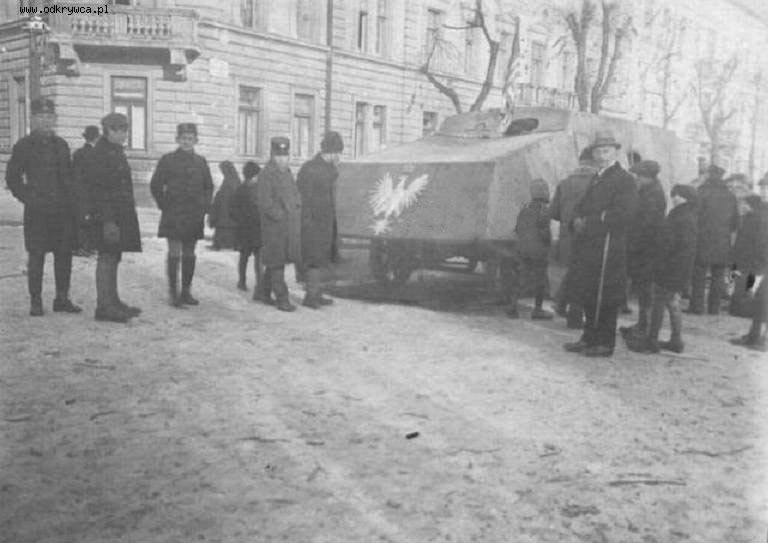
Demonstration of an armored car Tank Piłsudskiego population. Photo Aviarmor.net
According to the most famous version, immediately after the start of open hostilities, Professor Anthony Markovsky suggested that the leadership of the Senkevich Army School should develop and build an armored car. The military became interested in such a proposal and provided all the necessary support. In the shortest possible time, the initiator of the works submitted the necessary documentation, after which one of the nearest railway workshops received an order for the construction of a ready armored car.
A curious feature of the first Polish armored car was the uniquely short development and construction time of the finished vehicle. The offer appeared at the very beginning of November 1918. A full-fledged armored car rolled out of the shop already on November 8. How the Polish specialists managed to solve a rather complicated task in just a few days is unknown. It can be assumed that by the beginning of the Polish-Ukrainian war a certain reserve had been prepared for the construction of an armored car. After completing part of the required work in advance, the authors of the project, having received an order from the military, could complete construction as quickly as possible and give them the finished machine.
The new armored car received its own name - Tank Piłsudskiego ("Pilsudski Tank"). This car was also called the “Joseph Pilsudski”. Other designations, as far as is known, were not used. According to the existing project, it was planned to build only one new armored car. Thus, othersTanks Pilsudski "was simply absent.
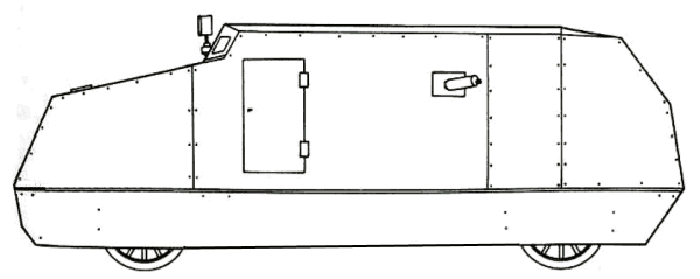
Scheme of the armored car. Photo Derela.republika.pl
According to available data, the idea of A. Markovskiy repeated the decisions of other designers and consisted in assembling the original armored hull onto an accessible automobile chassis. The basis for the future "tank" served as a truck of an unknown model, which had a rear-wheel drive two-axle chassis. Like other cars of its class, this truck was built on the basis of a rectangular metal frame. In front of it were placed the engine and manual transmission. According to some sources, the use of the chassis was equipped with a gasoline engine no more than 30-35 hp. The engine was connected with a relatively simple mechanical transmission, which served to transmit torque to the rear drive wheels.
In the few surviving photographs, one can see that the “Pilsudski Tank” has retained a fairly simple undercarriage. Two pairs of wheels of the spoke construction were installed on the bridges. The latter were equipped with a suspension on leaf springs. The front axle was connected to the steering. It can be assumed that the rear axle of the chassis has received gable wheels.
On top of the existing chassis should be installed armored body of its own design. It is known that it was collected from 10-mm sheets of various shapes and sizes. There is no reliable information about the architecture of the case. According to some sources, it was based on a body of metal profiles, while others indicate a direct connection of armor plates. Based on the peculiarities of the base truck, the authors of the project Tank Piłsudskiego used the bonnet layout of the new hull.
The first Polish armored car was distinguished by interesting contours of the protected body. Despite the complete lack of experience in this area, A. Markovsky and his colleagues were able to build a corps with anti-bullet and anti-splinter protection, to a certain extent consistent with the principle of rational angle of inclination.
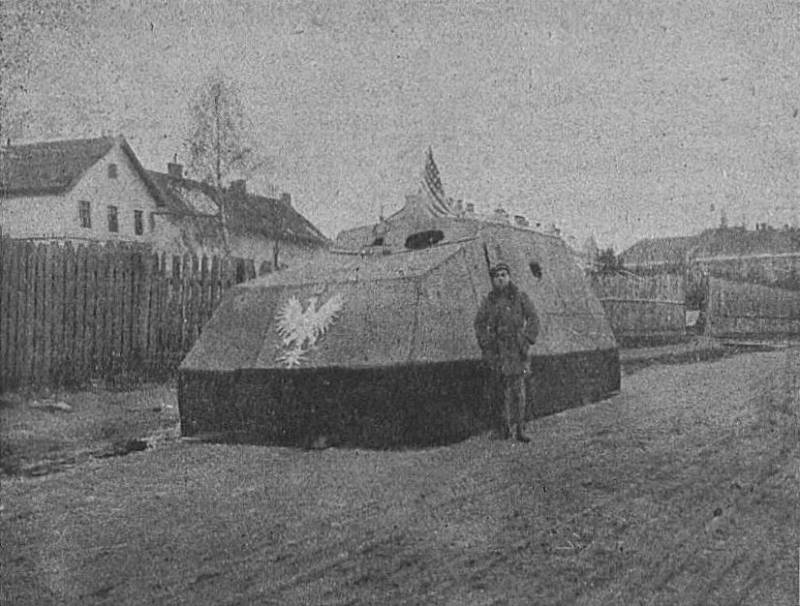
The armored vehicle shortly after construction was completed, November 1918. The US flag was hoisted on the armored car. Photo of Wikimedia Commons
The engine compartment of the car was protected by several large sheets. The frontal projection consisted of a lower inclined trapezoid sheet, a large inclined roof, and a wedge-shaped unit that served as the forehead of the habitable compartment. On the side of the engine and related equipment were covered with inclined sides of the appropriate form.
The sides of the engine compartment were in the same plane with the side sheets of the habitable volume, but the latter differed slightly more in height. The cross section of the hull remained the same up to the feed unit. The stern of the hull had a pair of inclined sheets that formed relatively smooth shapes. The roof of the case was made in the form of a slightly curved rectangular part.
The most interesting feature of the Józef Piłsudski armored vehicle was the original chassis protection. On the lower part of the sides of the main building, the designers secured the screens that sank almost to the ground and protected the wheels with bridges from some threats. What these screens were made from is unknown. There is information about the installation of rectangular armor plates of great length, however, some photos suggest the use of a certain mesh or other similar device.
Armament "Tank Pilsudski" was to consist of four machine guns. The preserved photos show that the car received weapon with characteristic large barrel covers used by water cooling. Thus, given the resources of the young state, it can be assumed that the armored car could carry MG 08 or Schwarzlose machine guns. In addition, we can not exclude the possibility of simultaneous use of machine guns of two models.
Machine guns should be installed in the embrasures of the body. The first of them was in the right side of the frontal sheet of the habitable compartment. It was a round opening with a movable rectangular lid. Depending on the need, the shooter could open the lid and expose the machine gun, or remove the weapon and close the hatch. Two other embrasures located in the central part of the sides. Unlike the frontal, they were left without covers and could not close. The location of the fourth embrasure - if it was present - is unknown. Apparently, it could be placed on the stern of the hull.
The method used to place weapons allowed the shooters to control the maximum possible space. Each of the four machine guns blocked a certain sector in front, on the sides and behind the machine. At the same time, certain dead zones could be present, not fired by any of the machine guns.
The crew of the armored car Tank Piłsudskiego was supposed to consist of seven or eight people. The first of them was the commander, the other two were assigned the functions of driver mechanics, and the others were to monitor the surrounding space, search for targets and fire at them from existing machine guns. A specific feature of the crew’s work was a limited view from the habitable hull compartment. So, the driver could follow the road only with the help of a small viewing hatch in the front plate. The shooters, in turn, were asked to use only small embrasures, partially covered with machine gun covers.
Access to the inside of the armored car was provided by at least one side door. It is authentically known that on the left side, near the driver's place there was an opening for the installation of the door. Whether the second door was present on the starboard side is unknown.
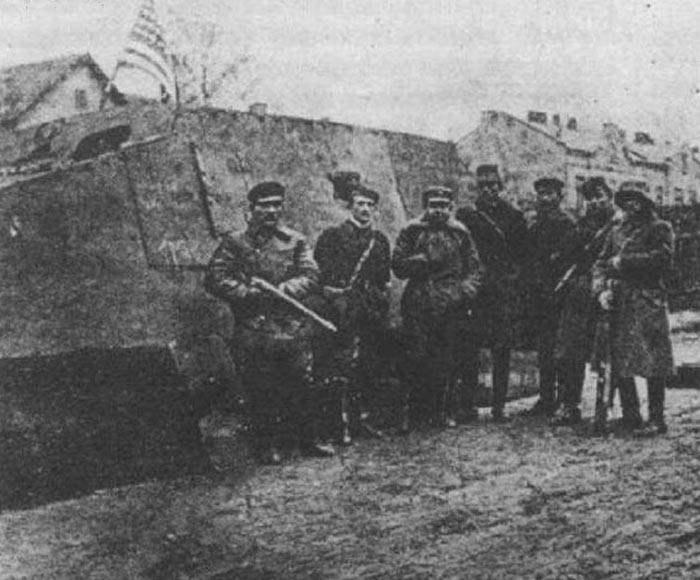
"Tank Pilsudski" and its crew. Photo Aviarmor.net
According to various estimates, the first Polish armored car was of medium size. Its total length reached 6,2-6,5 m with a width of no more than 2,2-2,5 m and height up to 2,2 m. Combat weight is on the order of 5 t. Not the highest characteristics of the base chassis led to a certain degradation of driving characteristics. Without any problems, the car could move only along good roads and city streets. If we take into account the peculiarities of the further operation of the Tank, then such restrictions did not lead to serious problems.
It is worth noting that the authors of the Józef Piłsudski project paid attention not only to technical aspects, but also to the appearance of their car. She received a monotone coloring of a dark shade (perhaps a protective or gray color). In addition, on the front sheet drew a Polish eagle. However, some photographs suggest that the eagle was not a drawing, but a separate volumetric detail.
The proposal to build a Tank Pilsudski was received at the very beginning of November 1918. Already on November 8, a finished machine assembled in Lviv’s railway workshops was shown to future operators. It is possible that on this day several interesting photos of an armored car were taken. In these pictures, the Polish fighting vehicle carried the American flag. The latter was a kind of response to the statements of US President Woodrow Wilson, who indicated the support of the young Polish state.
The crew was immediately formed. Commander of the first armored car in Poland was Lieutenant Edward Sak-Svistelynsky. The duties of drivers were assigned to Eugeniusz Bernaisc and Wladyslaw Kubal. Stefan Zambelli, Mechislav Kretovich, Edward Kustanovich and Bronislav Niziol became arrows machine gunners. Subsequently, the crew probably changed several times.
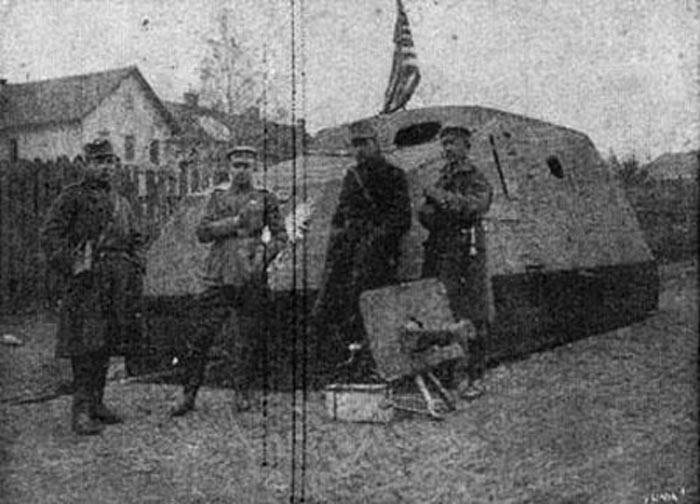
Armored car, crew and weapons. Photo Aviarmor.net
Already 9 November, the crew received the first combat mission. In accordance with the order of the command, Tank Piłsudskiego was to move to Lviv Mickiewicz Street and provide support for the advancing infantry. Fighters of the West Ukrainian People's Republic became aware of the armored vehicle’s entry into the “battlefield”. Understanding the danger of an armored car, they prepared defensive positions. A moat of sufficient size appeared on one of the street sections, behind which a barricade was staged. In addition, an ambush was arranged near a similar barrier.
Accompanying the advancing infantry, the armored car was able to pass part of a given route, but was forced to stop in front of the moat and barricade. The presence of the barrier and limited maneuverability led to the fact that the crew could not fire at the enemy from several machine guns at once, and the actual firepower of the machine was insufficient. In addition, "Józef Pilsudski" fell under enemy fire. After analyzing the situation, lieutenant Sak-Svistelynsky gave the order to retreat. Thus ended the first battle of the first Polish armored car.
After its first battle, which took place on Mitskevich Street, the armored car needed minor repairs. Having completed the restoration of equipment, the Polish army again sent it to battle. According to some reports, the next time it was used on November 22, during the so-called. Lviv pogrom. According to some reports, the crew of the car participated in suppressing riots in the Krakow area. How successful his work as a police car was is unknown.
Unfortunately for historians, the 22 events of November 1918 of the year are the last reliably known episode of stories Poland's first armored car. Exact information about the future of the Tank Piłsudskiego car is not available. According to the most common and most plausible version, soon after the end of the battles for Lviv, this armored car, along with several other machines of its class, became part of a specially formed platoon of Zwiazek Aut Pancernych.
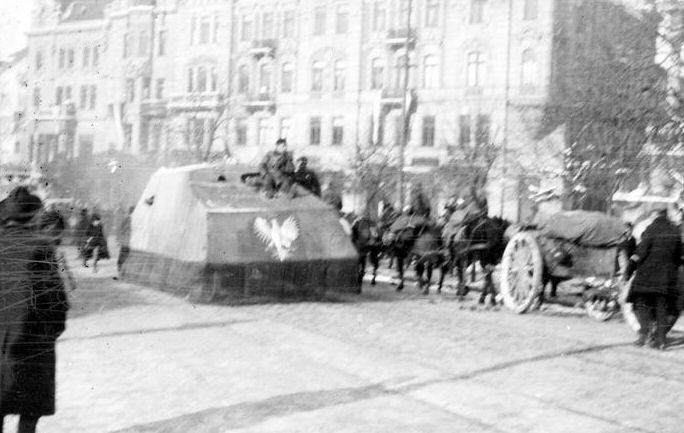
Armored car on the streets of Lviv. Photo Derela.republika.pl
Historians managed to establish some details of the service of this unit, but the exact information about the work of the armored car Józef Piłsudski still remains unknown. How he served, what operations he participated in, what results he showed and how he ended his career - it remains only to guess. With confidence we can only say that this car did not have to stand idle without work. The Polish-Ukrainian war lasted until the mid-summer of 1919, and by that time all the existing armored cars of the Polish Republic could take part in a mass of battles.
Perhaps the first Polish armored car was destroyed by the enemy during one of the battles. At the same time, it cannot be ruled out that he continued his service up to the development of a resource and write-off for the lack of prospects. Anyway, no later than the beginning of the twenties, Tank Piłsudskiego ceased to exist.
Wanting to gain an advantage over the enemy, the young Republic of Poland created several armored cars of its own design. The first of the new cars built and put into operation was A. Markovsky’s “Tank of Piłsudski” design. This sample was not distinguished by the perfection of the design, high performance and wide capabilities, but it could solve the tasks assigned to it. With all his shortcomings, he was able to strengthen the infantry units, and in addition, to give impetus to the further development of Polish armored vehicles.
On the materials of the sites:
https://aviarmor.net/
http://derela.republika.pl/
http://histografy.pl/
https://wozybojowe.pl/
http://pbc.rzeszow.pl/
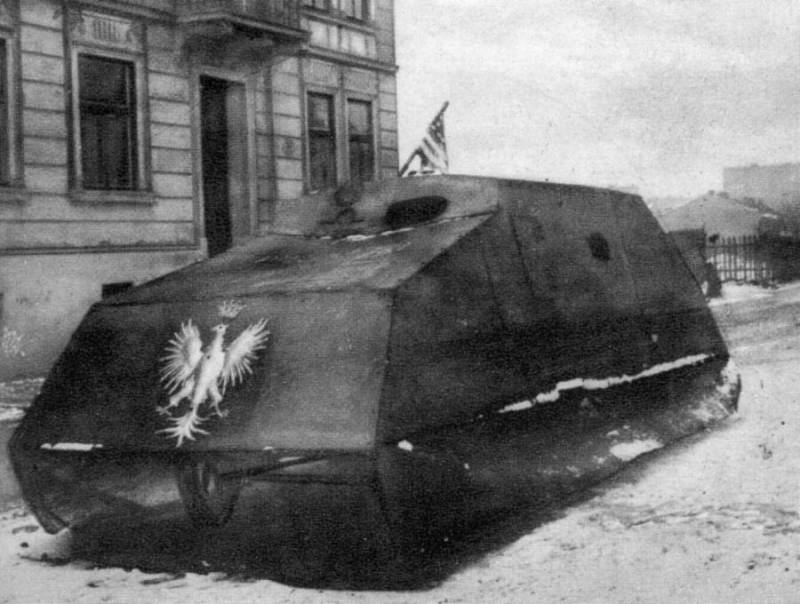
Information